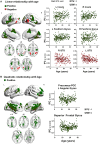Age-related changes in intrinsic function of the superior temporal sulcus in autism spectrum disorders
- PMID: 25809403
- PMCID: PMC4590540
- DOI: 10.1093/scan/nsv029
Age-related changes in intrinsic function of the superior temporal sulcus in autism spectrum disorders
Abstract
Currently, the developmental trajectories of neural circuits implicated in autism spectrum disorders (ASD) are largely unknown. Here, we specifically focused on age-related changes in the functional circuitry of the posterior superior temporal sulcus (pSTS), a key hub underlying social-cognitive processes known to be impaired in ASD. Using a cross-sectional approach, we analysed resting-state functional magnetic resonance imaging (fMRI) data collected from children, adolescents and adults available through the autism brain imaging data exchange repository [n = 106 with ASD and n = 109 typical controls (TC), ages 7-30 years]. The observed age-related changes of pSTS intrinsic functional connectivity (iFC) suggest that no single developmental pattern characterizes ASD. Instead, pSTS circuitry displayed a complex developmental picture, with some functional circuits showing patterns consistent with atypical development in ASD relative to TC (pSTS-iFC with fusiform gyrus and angular gyrus) and others showing delayed maturation (pSTS-iFC with regions of the action perception network). Distinct developmental trajectories in different functional circuits in ASD likely reflect differential age-related changes in the socio-cognitive processes they underlie. Increasing insight on these mechanisms is a critical step in the development of age-specific interventions in ASD.
Keywords: autism brain imaging data exchange; autism spectrum disorders; developmental changes; intrinsic functional connectivity; posterior superior temporal sulcus.
© The Author (2015). Published by Oxford University Press. For Permissions, please email: journals.permissions@oup.com.
Figures




References
-
- Akaike H. New look at statistical-model identification. Transactions on Automatic Control. 1974;19:716–23.
-
- Allison T, Puce A, McCarthy G. Social perception from visual cues: role of the STS region. Trends in Cognitive Science. 2000;4:267–78. - PubMed
Publication types
MeSH terms
Grants and funding
- F31 DC010143/DC/NIDCD NIH HHS/United States
- K08 MH092697/MH/NIMH NIH HHS/United States
- R21MH084126/MH/NIMH NIH HHS/United States
- P50 MH060450/MH/NIMH NIH HHS/United States
- K23MH087770/MH/NIMH NIH HHS/United States
- R21 MH084126/MH/NIMH NIH HHS/United States
- P50MH60450/MH/NIMH NIH HHS/United States
- R01 MH081218/MH/NIMH NIH HHS/United States
- T32 DC008553/DC/NIDCD NIH HHS/United States
- R01 MH080826/MH/NIMH NIH HHS/United States
- T32DC008553/DC/NIDCD NIH HHS/United States
- R01HD065282/HD/NICHD NIH HHS/United States
- R01 HD065282/HD/NICHD NIH HHS/United States
- R01MH081218/MH/NIMH NIH HHS/United States
- R01 NS034783/NS/NINDS NIH HHS/United States
- K23 MH087770/MH/NIMH NIH HHS/United States
- R01MH080826/MH/NIMH NIH HHS/United States
- R01NS34783/NS/NINDS NIH HHS/United States
LinkOut - more resources
Full Text Sources
Other Literature Sources
Medical

